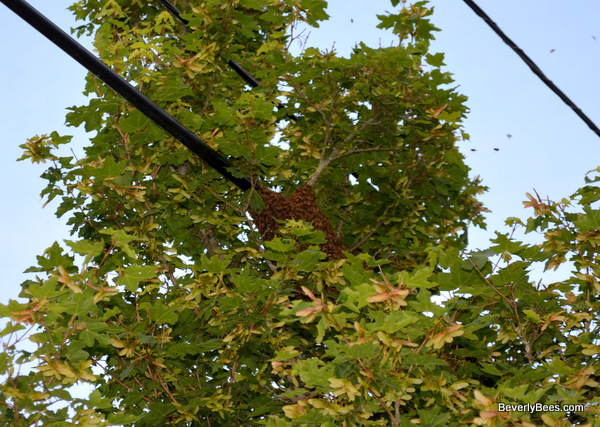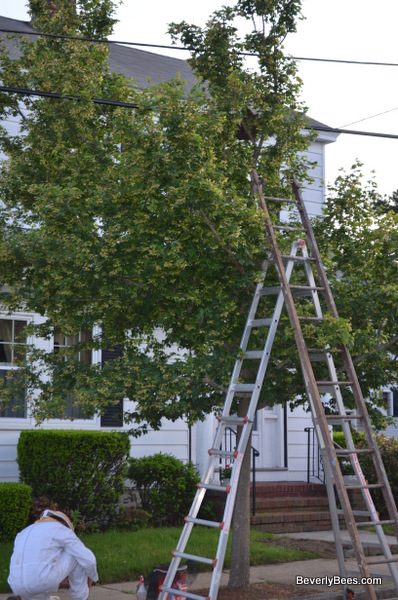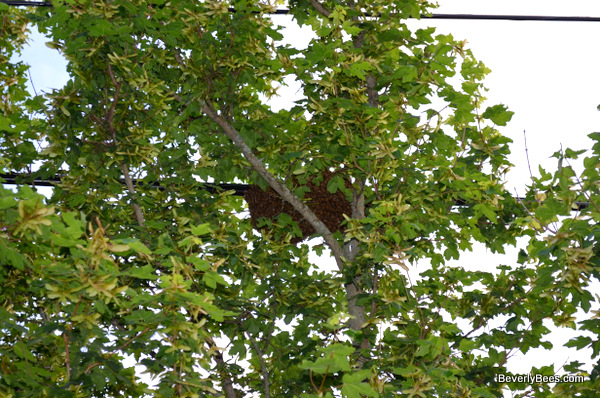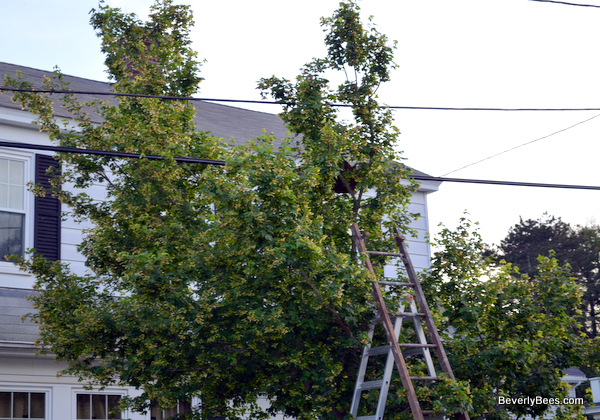“There’s A Bee Swarm On The Power Lines”
This year has been a record setter for the number of bee swarms in our area. I think the warm winter and spring with periods of rain followed by bright sunny days has created the perfect conditions for swarming. In fact, only two days after being added to the local swarm catching list, Brian and I received our first official swarm call. Turns out the caller was a beekeeper friend, Beth. Since she did not have a place to put these bees, she called me. “Anita, there’s a bee swarm outside my house on the power lines. Do you want to get it.”
Here I am excited for our first official swarm call thinking, Um – No! The last thing I want is to be electrocuted trying to catch a bee swarm. “Are you sure it’s on the power lines?” I asked. But after talking with her further and having her describe the location more precisely to both Brian and I, Brian was pretty confident it was on the communications line for telephone/cable, not the power line. We got the gear ready and kids in tow, we headed over to Beth’s house. We arrived there around 6:30 PM.
Let me preface the rest of this post by saying if you find a bee swarm on the “power lines” it is NOT a good idea to try to capture it. Doing so is very dangerous and could be deadly, unless you know exactly which lines are safe to touch. It’s not worth risking your life to catch a bee swarm. In other words – “DO NOT try this at home!”
Luckily for us, Brian has significant experience identifying these wires. Whoever thought that would come in handy during beekeeping? This is what we found when we arrived.

Brian was able to tell this swarm was located on the communication line and far enough away from the power lines that it would be safe for us to retrieve it. There was no way we would come in contact with the power lines while trying to capture this bee swarm. The bees were actually clustered on both the communications wire and the tree trunk about 15 feet in the air. We braced two ladders together to get near the swarm as seen below.

By the time Brian and I were suited up, the entire neighborhood was out watching the swarm catching fun (from a safe distance of course). There were branches in the way and since we could not cut the tree this made it a bit challenging to get at the bee cluster.

Brian was excited to try his hand at swarm catching so he took the first attempt at it. He climbed up the wooden ladder and sprayed the bees gently with sugar water to keep them from flying around too much. Then he placed the bucket under the swarm on the wire and shook the tree branch hard, banging it against the wire. He got about half of the swarm in the first try.
Brian passed the bucket down to me and I placed a screen on top with a slit in it and secured it with a rubber band. Then we watched the bees. One by one they began fanning so we knew we had the queen. Bees from above began circling around the bucket and landing on the screen, then going inside the bucket through the slit in the screen. (Unfortunately, my camera battery died so I was not able to get pictures of this extraordinary scene or much of this capture.)
A significant number of bees were still clustered on the wire. This time I went up the ladder and using another bucket I sprayed the cluster again with sugar water then shook the wire hard. The bees on the wire fell into the bucket. I climbed down the ladder and Brian and I combined the two buckets of bees together. After a few minutes, the bees began fanning aggressively on top of the screen. The entire cover of the bucket was filled with bees, with their butts in the air, fanning so the other bees would smell the nasonov pheromone and join them.
At this time another beekeeper showed up with his swarm vacuum. Beth called him first but he was too busy getting another swarm in the area and didn’t think he could make it here. Although disappointed we beat him to it, he was very glad we captured the swarm after seeing it was on the wires. He said the wires made him very nervous and he was not sure he could have captured these bees. He was also amazed to see the bees going into the bucket through the slit on the screen, at first he didn’t believe it.
We then placed the bucket on top of the metal ladder so the bees flying in the air would smell the nasonov pheromone easier and come down into the bucket.
 We left the bucket there for a while and talked about swarm catching with the other beekeeper. Beth generously fed my kids and they were having a great time playing with other kids in the neighborhood. It was getting dark now and still some bees were clustered on the branch and not moving toward the queen. So I removed the bucket with the queen off the ladder. Brian and the other beekeeper tried hooking up the power to the bee vacuum the other beekeeper brought but the outlet on the house wasn’t working.
We left the bucket there for a while and talked about swarm catching with the other beekeeper. Beth generously fed my kids and they were having a great time playing with other kids in the neighborhood. It was getting dark now and still some bees were clustered on the branch and not moving toward the queen. So I removed the bucket with the queen off the ladder. Brian and the other beekeeper tried hooking up the power to the bee vacuum the other beekeeper brought but the outlet on the house wasn’t working.
By the time a working outlet was found, I had already gone up the ladder a third time, sprayed the remaining bees with sugar water and brushed them into a bucket. I put a screen on top (without a hole in it) and secured it with a large rubber band. There were still some bees in the air but it was dark now and getting late. I was confident we had the queen and the bulk of the bees, so we loaded the car back up, dressed the kids in bee suits for the ride home (just in case any bees escaped) and three hours after we started we went home to rehive the swarm. Most of this time was spent talking shop and waiting for the bees to go into the bucket on their own.
After putting the kids to bed, I went outside and set up the hive on the roof and dumped the bees inside. It was 10:30 at night by them time I was done. This was the first time I hived bees in the dark and it was so much easier than doing it during the daytime. All the bees went right inside with very few flying into the air.
The next day the bees were already bringing pollen into the hive, so I think it’s safe to say they are happy in their new home on the roof and glad to be off the “power” lines. Now I just need to think of a name for them. Any suggestions for naming this adventurous swarm?
Other Posts You May Enjoy:
- Flame Duct Tape, A Rock, Orange String And Debbie’s Bee Swarm
- My First Bee Swarm
- Duct Tape, A Rock And A String Saved My Swarm
- In Case You’re Wondering Bees Can Chew Through Garden Row Cover
- A Hive with Two Queens
This post was shared on Farmgirl Friday and the Barn Hop.
